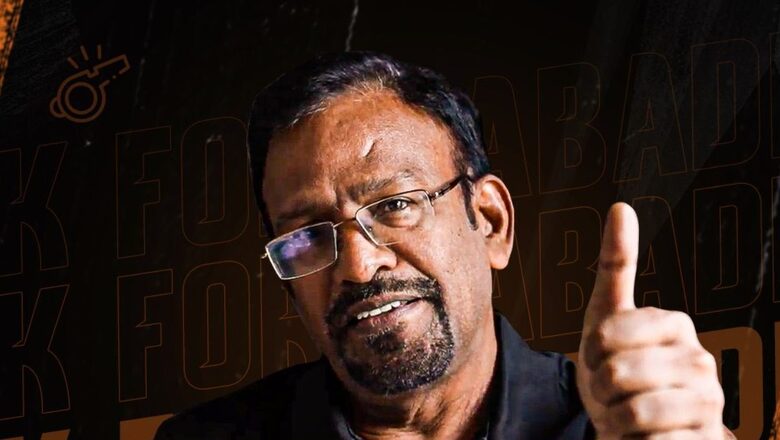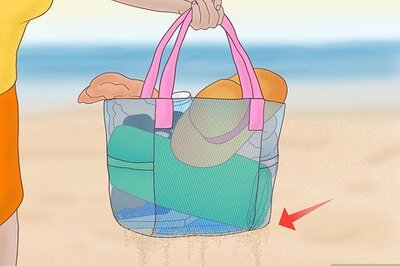
views
Kabaddi has grown in leaps and bounds in recent years. Kabaddi is one of the traditional Indian sports that has its existence in the mythological history of the country. And it is now enjoying a purple patch with the advent of the Pro Kabaddi League.
One of the persons at the centre of the development of the sport is E Prasad Rao. Rao is the current Technical Director of the Pro Kabaddi League and has been the Technical Director of the International Kabaddi Federation for the past 20 years.
Rao has been a pivotal figure in revolutionizing the sport. In an exclusive conversation with CNN News-18, Rao shares his experiences right from the time he plunged into Kabaddi and how he has helped develop and improvise the game over the years.
Can you highlight a bit of your journey. How did you develop interest in Kabaddi? And how did you go from E Prasad Rao to being Kabaddi Rao, what people now call you fondly?
My journey is a very long journey. I have completed more than 43 years with this sport. Basically, I was a player, but not at a very high level. My school is from Andhra Pradesh in Vijayanagar. My school was a Municipality school, not a rich school. The main sports in that school were Kabaddi and Kho Kho. My Physical education teacher motivated me to play Kho Kho.
I was a Kho Kho player first and then played Kabaddi. I played both Kho Kho and Kabaddi at the national level. I could not play at a very higher level because of my height and weight. I wanted to become a Physical Education teacher. Then I did a diploma and joined as a Physical Education teacher in a school in Orissa.
One morning, somebody told me, ‘why don’t you become a coach?’ Then I came to know that there is a coach. I went to Bangalore to NIS to do a diploma in coaching. Fortunately, the same institute wanted me as a teaching faculty member. So I joined there as a Kabaddi coach. That was in 1981. I slowly stopped Kho Kho and was totally involved in Kabaddi. Kabaddi at that point in time was a rural sport, played mostly in villages. Very less participation from women. It was injury prone and the games looked a rough game. People used to think, Kabaddi nahi khelna hai, chot lagega. That was the impression Kabaddi was giving.
Kabaddi was a poor men’s sport back then. We could not afford to play sports including ball. Our families were also middle class. So for most of our villages’ people, Kabaddi was favourite sport.
When I received Dronacharya Award in 2002, Abdul Kalam told that Kabaddi was his favourite sport. It is our culture.
I was the coach for the 1990 Asian Games Indian team. I was the first coach for the Indian team. I found, Kabaddi was introduced in the 9th Asian Games in New Delhi. When I compared Kabaddi and other sports, the standard was lacking. If you want it to be an international sport, you need to develop from all the angles, the infrastructure, the facilities, the type of game, etc. So we started making new rules. We introduced the Bonus Line Rule. When there are six-seven players, if the rider doesn’t touch a defender, but touches the line, he gets one point.
Similar rules were created and we tried to make the game a little faster and a little attractive, but still we were lacking.
In 1990, first Asia Games for Kabaddi, India won only one gold medal that was in Kabaddi. Then I thought, we can’t continue playing on mud. If you want Europe and USA to play, it is impossible. If this continues, maximum six–seven countries will play Kabaddi.
After winning the Dronacharya Award, I left coaching Indian team. I started working on the development of the game. I went to many countries and introduced the game to them. Then, I started working on different mats. We tried gymnastics mat, Judo mat, Volleyball mat.
We conducted a competition in Pune in 1994-95 and confirmed that Kabaddi can be played on the mat. I was the coach of Sri Lankan team in 1998 and I saw a Taekwondo match. I requested for that mat and the boys said that this mat is feasible for Kabaddi.
Transfer Window June 15 LIVE Updates: Newcastle Interested in Nicolas Barella, Christophe Galtier Could Replace Luciano Spalletti at Napoli
Then slowly I tried to convince all the countries that we have to shift to mat. So they changed my name from E Prasad Rao to Kabaddi Rao.
I think it’s fair to say that. You not only changed the Kabaddi from mud to mat but also introduced various rules. Any other rule that you changed besides the Bonus Line Rule?
We made many changes like Bonus line, Baulk line. Recently, we made changes [after the advent of] Pro Kabaddi.
How does India’s Kabaddi infrastructure compare to other countries? Can we say India has one of the best infrastructure in current times, or not yet?
As compared to other countries, India has better infrastructure, no doubt. But what kind of infrastructure is required? If you go to Bangalore or Chennai, you have a football stadium. If you go to Delhi, you have a football stadium. But we don’t have any dedicated stadium. It’s a multi-purpose hall where Kabaddi, Basketball, Volleyball everything will be played. I am not saying we don’t have infrastructure. For example, the Sports Authority of India (SAI) has 20-30 sports hostels. But this is not sufficient when you compare with other sports. If you compare it with cricket, you will see one or two stadiums in each state that are at par with international standards.
There are 50 international venues for cricket in India.
I was visiting professor with Taisho University in Tokyo. They have a dedicated Kabaddi hall, which we don’t have. The Central and State Government need to make their own infrastructure for the sport.
Now, as far as playing on mat is concerned, I was opposed at first. They compared it with Hockey. They said just as India lost the grip in Hockey after turf was introduced, we might face a similar situation in Kabaddi. But I convinced them and started first Kabaddi court with mat in Gandhinagar. After all these years, even school tournaments are played on mats. The very people who were saying that Rao will spoil Kabaddi now tell me that I have done very good work for Kabaddi.
So infrastructure is good, but I feel every school should have a Kabaddi mat. Other countries are asking [to import] mats from India.
Okay. When we talk about these mats, I have two questions. Are the mats used in PKL and International tournaments different from mats used in domestic tournaments like Khelo India? And secondly, how are the manufacturers who produce these mats approved by the government or the Kabaddi board?
We used the first for the first time in Asian Games in 2002. We have made many experiments in the next 20 years. And after Pro Kabaddi, they standardized the mats. The International Kabaddi Federation now has set specific standards for the mat. So in all these tournaments including Khelo India, the mats are standardized. But in inter-school tournaments they use local mats. I have friends who rent Kabaddi mats for tournaments. This has become an industry. Otherwise, there is standardization. And we are producing very good mats after Korea.
And what about these manufacturers? Are there any criteria that are considered while approving this?
I cannot answer this. For example if Haryana or Andhra Pradesh state government are producing mats, their sports committee or sports development authority will decide. But if you go to International Kabaddi Federation website, they have the specifications for the mats for example, the thickness of mat should be 25-40 mm. But even today we are trying to experiment with mats.
And there are many manufacturers, but one manufacturer who is with us, and supplying mats for Pro Kabaddi, and they have got a certificate from International Kabaddi Federation, is Gravolite. If somebody asks me, I always suggest them for Gravolite.
Okay! Sometimes we keep hearing that there is a misdemeanour going on with the sports federations. So what can be done so that they can function better, especially in their tie up with these manufacturing entities?
I don’t think I am competent to speak on this. I am only a technical expert. I don’t deal with such issues or don’t deal with the manufacturers. I might tell them that the mats shall be less slippery. But I am not involved in state governments’ purchases.














Comments
0 comment